Diploma in Acoustics and Noise Control: Ultrasound Assignment Report
VerifiedAdded on 2022/08/24
|14
|3429
|10
Report
AI Summary
This report delves into the multifaceted world of airborne ultrasound, beginning with a comprehensive overview of its diverse applications. It explores the utilization of ultrasound in various contexts, including leak detection, condition monitoring, electrical inspections, and medical examinations, providing detailed descriptions of each application and the typical pressure levels involved. Furthermore, the report examines the physical properties of sound waves in air, specifically focusing on air absorption and its dependence on factors such as frequency, humidity, temperature, and pressure, accompanied by a calculation of air absorption under specific conditions. Finally, the report addresses the growing concern of public exposure to airborne ultrasound, analyzing the potential health effects, both objective and subjective, and proposing possible limits on exposure levels to mitigate the risks and ensure public safety, referencing existing guidelines and suggesting further policy implementations.

Running head: ULTRASOUND 1
Ultrasound
Name
Institution
Ultrasound
Name
Institution
Paraphrase This Document
Need a fresh take? Get an instant paraphrase of this document with our AI Paraphraser
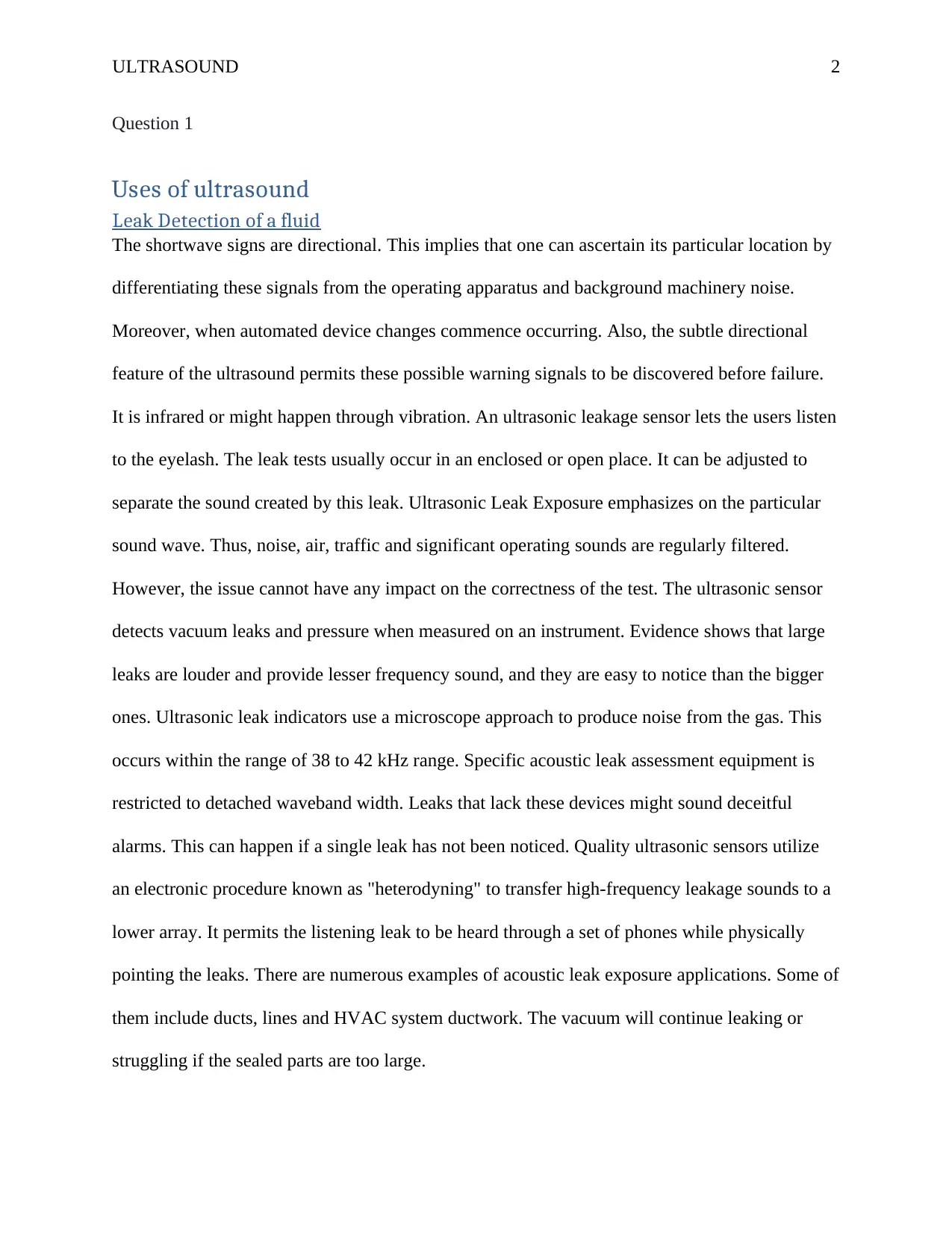
ULTRASOUND 2
Question 1
Uses of ultrasound
Leak Detection of a fluid
The shortwave signs are directional. This implies that one can ascertain its particular location by
differentiating these signals from the operating apparatus and background machinery noise.
Moreover, when automated device changes commence occurring. Also, the subtle directional
feature of the ultrasound permits these possible warning signals to be discovered before failure.
It is infrared or might happen through vibration. An ultrasonic leakage sensor lets the users listen
to the eyelash. The leak tests usually occur in an enclosed or open place. It can be adjusted to
separate the sound created by this leak. Ultrasonic Leak Exposure emphasizes on the particular
sound wave. Thus, noise, air, traffic and significant operating sounds are regularly filtered.
However, the issue cannot have any impact on the correctness of the test. The ultrasonic sensor
detects vacuum leaks and pressure when measured on an instrument. Evidence shows that large
leaks are louder and provide lesser frequency sound, and they are easy to notice than the bigger
ones. Ultrasonic leak indicators use a microscope approach to produce noise from the gas. This
occurs within the range of 38 to 42 kHz range. Specific acoustic leak assessment equipment is
restricted to detached waveband width. Leaks that lack these devices might sound deceitful
alarms. This can happen if a single leak has not been noticed. Quality ultrasonic sensors utilize
an electronic procedure known as "heterodyning" to transfer high-frequency leakage sounds to a
lower array. It permits the listening leak to be heard through a set of phones while physically
pointing the leaks. There are numerous examples of acoustic leak exposure applications. Some of
them include ducts, lines and HVAC system ductwork. The vacuum will continue leaking or
struggling if the sealed parts are too large.
Question 1
Uses of ultrasound
Leak Detection of a fluid
The shortwave signs are directional. This implies that one can ascertain its particular location by
differentiating these signals from the operating apparatus and background machinery noise.
Moreover, when automated device changes commence occurring. Also, the subtle directional
feature of the ultrasound permits these possible warning signals to be discovered before failure.
It is infrared or might happen through vibration. An ultrasonic leakage sensor lets the users listen
to the eyelash. The leak tests usually occur in an enclosed or open place. It can be adjusted to
separate the sound created by this leak. Ultrasonic Leak Exposure emphasizes on the particular
sound wave. Thus, noise, air, traffic and significant operating sounds are regularly filtered.
However, the issue cannot have any impact on the correctness of the test. The ultrasonic sensor
detects vacuum leaks and pressure when measured on an instrument. Evidence shows that large
leaks are louder and provide lesser frequency sound, and they are easy to notice than the bigger
ones. Ultrasonic leak indicators use a microscope approach to produce noise from the gas. This
occurs within the range of 38 to 42 kHz range. Specific acoustic leak assessment equipment is
restricted to detached waveband width. Leaks that lack these devices might sound deceitful
alarms. This can happen if a single leak has not been noticed. Quality ultrasonic sensors utilize
an electronic procedure known as "heterodyning" to transfer high-frequency leakage sounds to a
lower array. It permits the listening leak to be heard through a set of phones while physically
pointing the leaks. There are numerous examples of acoustic leak exposure applications. Some of
them include ducts, lines and HVAC system ductwork. The vacuum will continue leaking or
struggling if the sealed parts are too large.
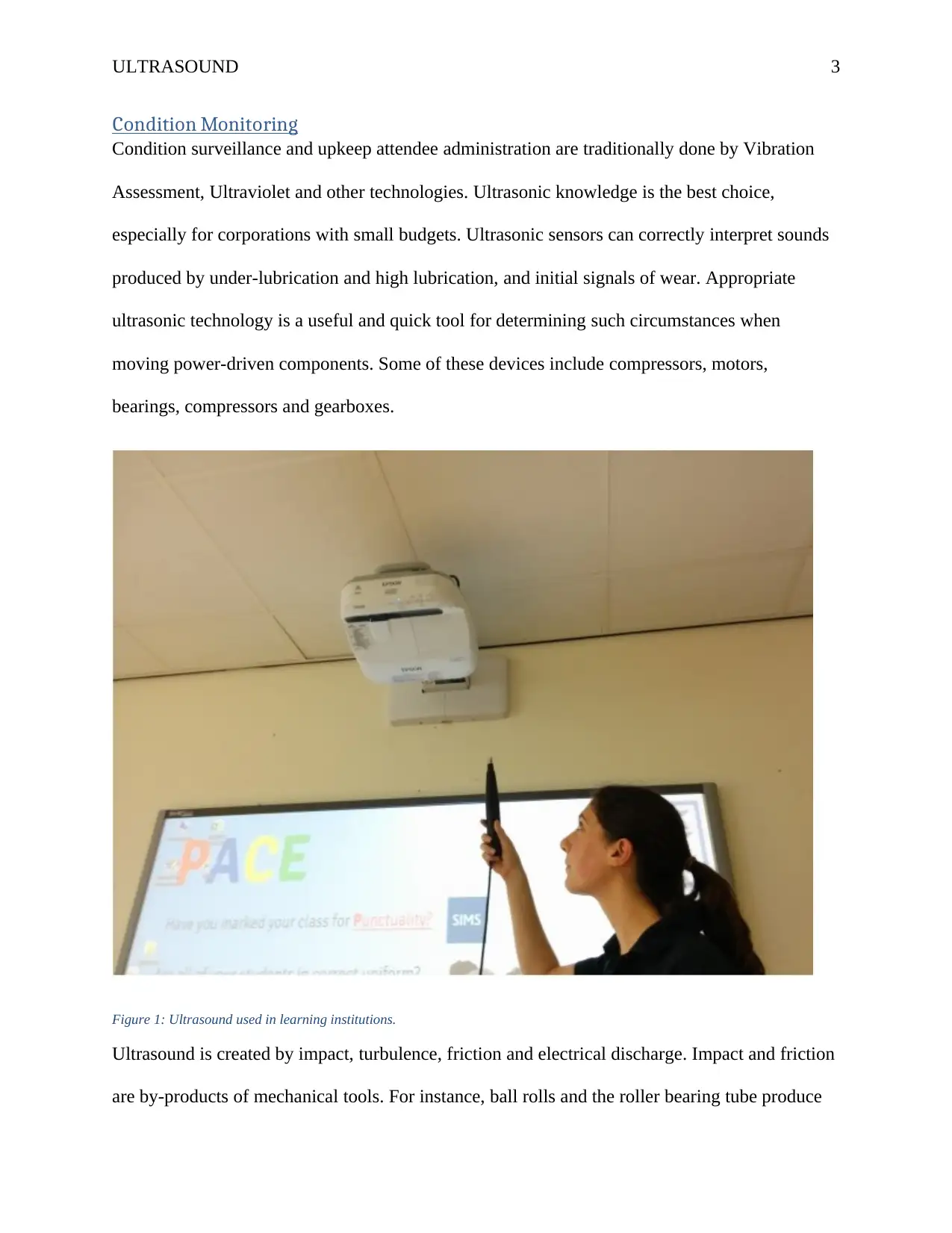
ULTRASOUND 3
Condition Monitoring
Condition surveillance and upkeep attendee administration are traditionally done by Vibration
Assessment, Ultraviolet and other technologies. Ultrasonic knowledge is the best choice,
especially for corporations with small budgets. Ultrasonic sensors can correctly interpret sounds
produced by under-lubrication and high lubrication, and initial signals of wear. Appropriate
ultrasonic technology is a useful and quick tool for determining such circumstances when
moving power-driven components. Some of these devices include compressors, motors,
bearings, compressors and gearboxes.
Figure 1: Ultrasound used in learning institutions.
Ultrasound is created by impact, turbulence, friction and electrical discharge. Impact and friction
are by-products of mechanical tools. For instance, ball rolls and the roller bearing tube produce
Condition Monitoring
Condition surveillance and upkeep attendee administration are traditionally done by Vibration
Assessment, Ultraviolet and other technologies. Ultrasonic knowledge is the best choice,
especially for corporations with small budgets. Ultrasonic sensors can correctly interpret sounds
produced by under-lubrication and high lubrication, and initial signals of wear. Appropriate
ultrasonic technology is a useful and quick tool for determining such circumstances when
moving power-driven components. Some of these devices include compressors, motors,
bearings, compressors and gearboxes.
Figure 1: Ultrasound used in learning institutions.
Ultrasound is created by impact, turbulence, friction and electrical discharge. Impact and friction
are by-products of mechanical tools. For instance, ball rolls and the roller bearing tube produce
⊘ This is a preview!⊘
Do you want full access?
Subscribe today to unlock all pages.

Trusted by 1+ million students worldwide
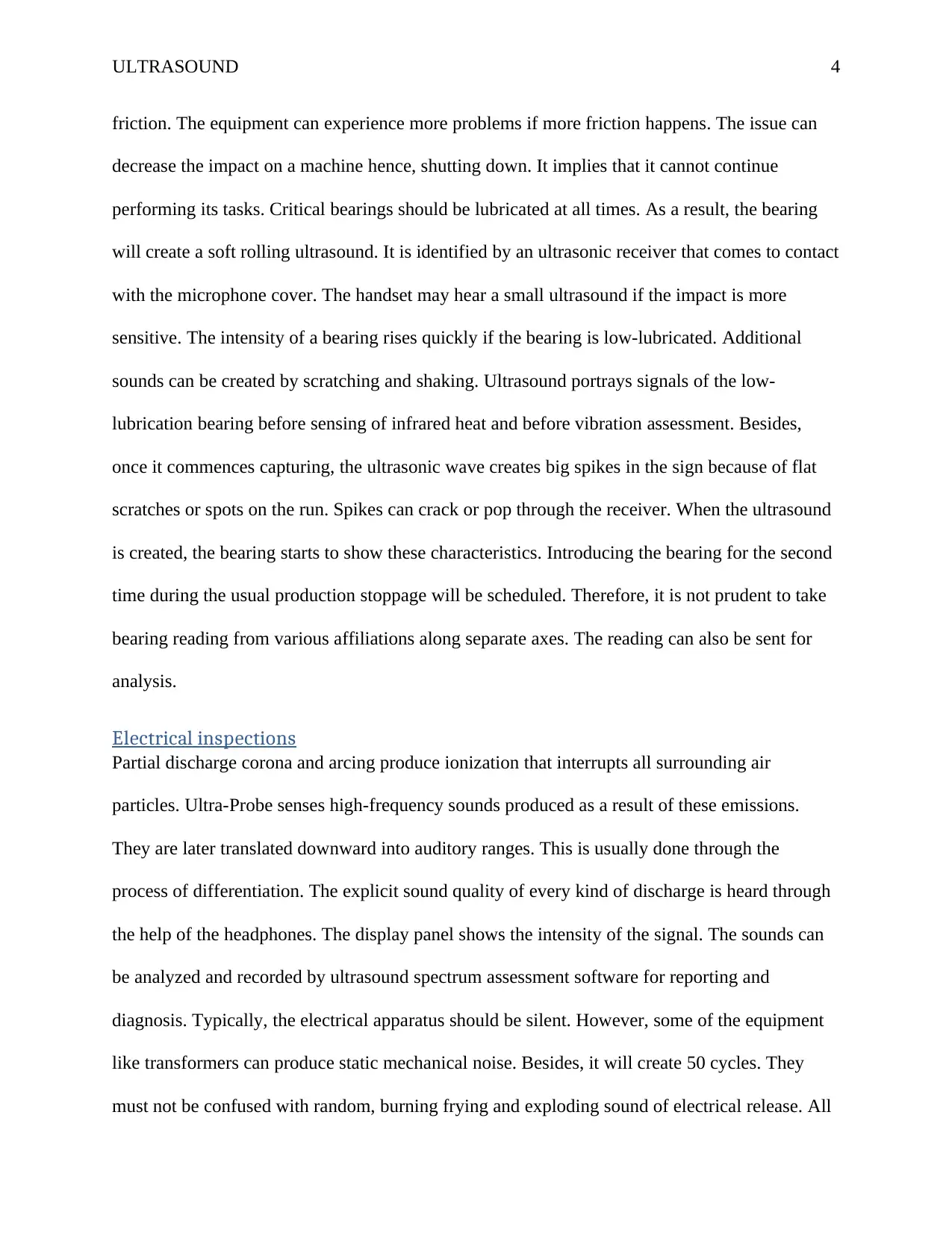
ULTRASOUND 4
friction. The equipment can experience more problems if more friction happens. The issue can
decrease the impact on a machine hence, shutting down. It implies that it cannot continue
performing its tasks. Critical bearings should be lubricated at all times. As a result, the bearing
will create a soft rolling ultrasound. It is identified by an ultrasonic receiver that comes to contact
with the microphone cover. The handset may hear a small ultrasound if the impact is more
sensitive. The intensity of a bearing rises quickly if the bearing is low-lubricated. Additional
sounds can be created by scratching and shaking. Ultrasound portrays signals of the low-
lubrication bearing before sensing of infrared heat and before vibration assessment. Besides,
once it commences capturing, the ultrasonic wave creates big spikes in the sign because of flat
scratches or spots on the run. Spikes can crack or pop through the receiver. When the ultrasound
is created, the bearing starts to show these characteristics. Introducing the bearing for the second
time during the usual production stoppage will be scheduled. Therefore, it is not prudent to take
bearing reading from various affiliations along separate axes. The reading can also be sent for
analysis.
Electrical inspections
Partial discharge corona and arcing produce ionization that interrupts all surrounding air
particles. Ultra-Probe senses high-frequency sounds produced as a result of these emissions.
They are later translated downward into auditory ranges. This is usually done through the
process of differentiation. The explicit sound quality of every kind of discharge is heard through
the help of the headphones. The display panel shows the intensity of the signal. The sounds can
be analyzed and recorded by ultrasound spectrum assessment software for reporting and
diagnosis. Typically, the electrical apparatus should be silent. However, some of the equipment
like transformers can produce static mechanical noise. Besides, it will create 50 cycles. They
must not be confused with random, burning frying and exploding sound of electrical release. All
friction. The equipment can experience more problems if more friction happens. The issue can
decrease the impact on a machine hence, shutting down. It implies that it cannot continue
performing its tasks. Critical bearings should be lubricated at all times. As a result, the bearing
will create a soft rolling ultrasound. It is identified by an ultrasonic receiver that comes to contact
with the microphone cover. The handset may hear a small ultrasound if the impact is more
sensitive. The intensity of a bearing rises quickly if the bearing is low-lubricated. Additional
sounds can be created by scratching and shaking. Ultrasound portrays signals of the low-
lubrication bearing before sensing of infrared heat and before vibration assessment. Besides,
once it commences capturing, the ultrasonic wave creates big spikes in the sign because of flat
scratches or spots on the run. Spikes can crack or pop through the receiver. When the ultrasound
is created, the bearing starts to show these characteristics. Introducing the bearing for the second
time during the usual production stoppage will be scheduled. Therefore, it is not prudent to take
bearing reading from various affiliations along separate axes. The reading can also be sent for
analysis.
Electrical inspections
Partial discharge corona and arcing produce ionization that interrupts all surrounding air
particles. Ultra-Probe senses high-frequency sounds produced as a result of these emissions.
They are later translated downward into auditory ranges. This is usually done through the
process of differentiation. The explicit sound quality of every kind of discharge is heard through
the help of the headphones. The display panel shows the intensity of the signal. The sounds can
be analyzed and recorded by ultrasound spectrum assessment software for reporting and
diagnosis. Typically, the electrical apparatus should be silent. However, some of the equipment
like transformers can produce static mechanical noise. Besides, it will create 50 cycles. They
must not be confused with random, burning frying and exploding sound of electrical release. All
Paraphrase This Document
Need a fresh take? Get an instant paraphrase of this document with our AI Paraphraser
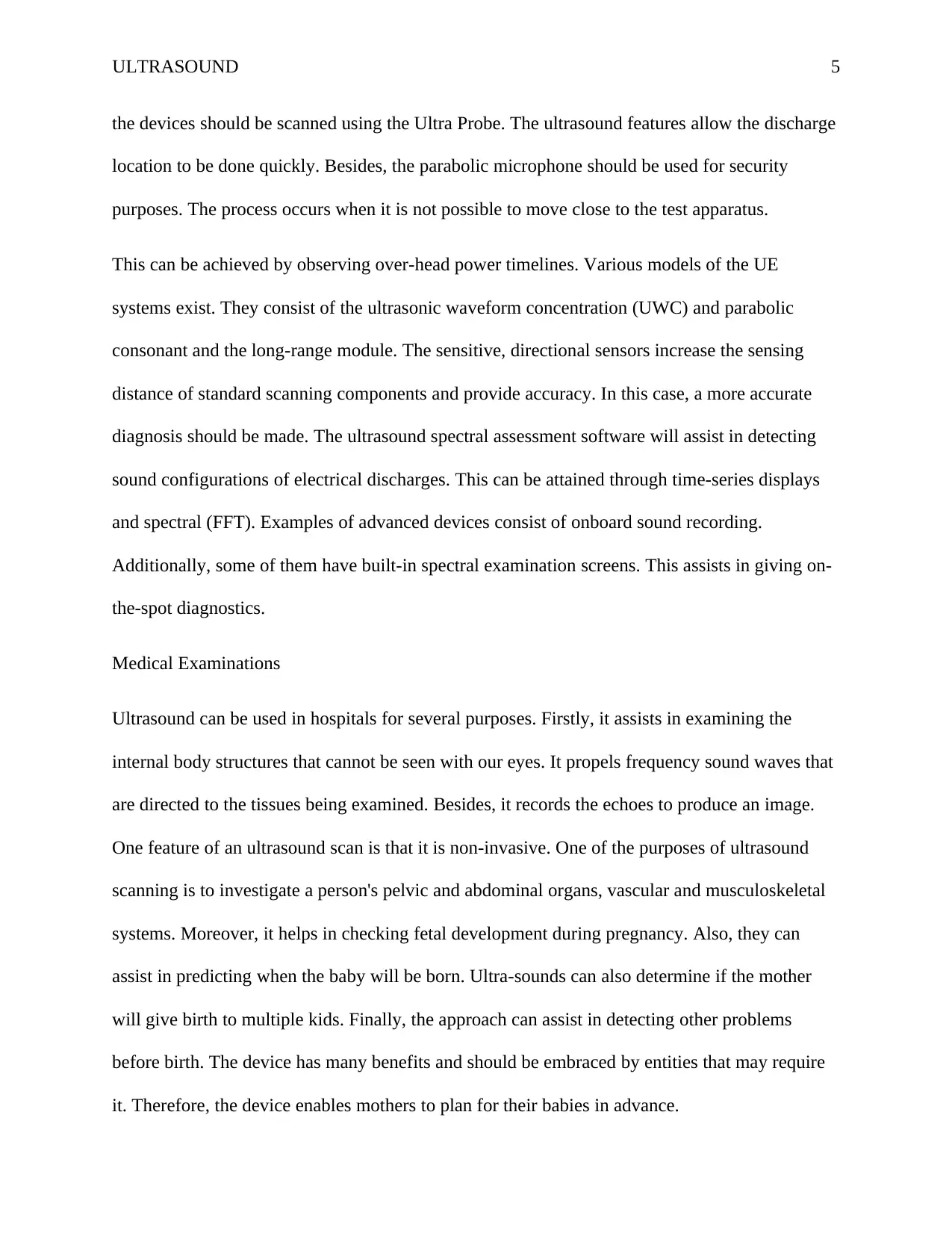
ULTRASOUND 5
the devices should be scanned using the Ultra Probe. The ultrasound features allow the discharge
location to be done quickly. Besides, the parabolic microphone should be used for security
purposes. The process occurs when it is not possible to move close to the test apparatus.
This can be achieved by observing over-head power timelines. Various models of the UE
systems exist. They consist of the ultrasonic waveform concentration (UWC) and parabolic
consonant and the long-range module. The sensitive, directional sensors increase the sensing
distance of standard scanning components and provide accuracy. In this case, a more accurate
diagnosis should be made. The ultrasound spectral assessment software will assist in detecting
sound configurations of electrical discharges. This can be attained through time-series displays
and spectral (FFT). Examples of advanced devices consist of onboard sound recording.
Additionally, some of them have built-in spectral examination screens. This assists in giving on-
the-spot diagnostics.
Medical Examinations
Ultrasound can be used in hospitals for several purposes. Firstly, it assists in examining the
internal body structures that cannot be seen with our eyes. It propels frequency sound waves that
are directed to the tissues being examined. Besides, it records the echoes to produce an image.
One feature of an ultrasound scan is that it is non-invasive. One of the purposes of ultrasound
scanning is to investigate a person's pelvic and abdominal organs, vascular and musculoskeletal
systems. Moreover, it helps in checking fetal development during pregnancy. Also, they can
assist in predicting when the baby will be born. Ultra-sounds can also determine if the mother
will give birth to multiple kids. Finally, the approach can assist in detecting other problems
before birth. The device has many benefits and should be embraced by entities that may require
it. Therefore, the device enables mothers to plan for their babies in advance.
the devices should be scanned using the Ultra Probe. The ultrasound features allow the discharge
location to be done quickly. Besides, the parabolic microphone should be used for security
purposes. The process occurs when it is not possible to move close to the test apparatus.
This can be achieved by observing over-head power timelines. Various models of the UE
systems exist. They consist of the ultrasonic waveform concentration (UWC) and parabolic
consonant and the long-range module. The sensitive, directional sensors increase the sensing
distance of standard scanning components and provide accuracy. In this case, a more accurate
diagnosis should be made. The ultrasound spectral assessment software will assist in detecting
sound configurations of electrical discharges. This can be attained through time-series displays
and spectral (FFT). Examples of advanced devices consist of onboard sound recording.
Additionally, some of them have built-in spectral examination screens. This assists in giving on-
the-spot diagnostics.
Medical Examinations
Ultrasound can be used in hospitals for several purposes. Firstly, it assists in examining the
internal body structures that cannot be seen with our eyes. It propels frequency sound waves that
are directed to the tissues being examined. Besides, it records the echoes to produce an image.
One feature of an ultrasound scan is that it is non-invasive. One of the purposes of ultrasound
scanning is to investigate a person's pelvic and abdominal organs, vascular and musculoskeletal
systems. Moreover, it helps in checking fetal development during pregnancy. Also, they can
assist in predicting when the baby will be born. Ultra-sounds can also determine if the mother
will give birth to multiple kids. Finally, the approach can assist in detecting other problems
before birth. The device has many benefits and should be embraced by entities that may require
it. Therefore, the device enables mothers to plan for their babies in advance.
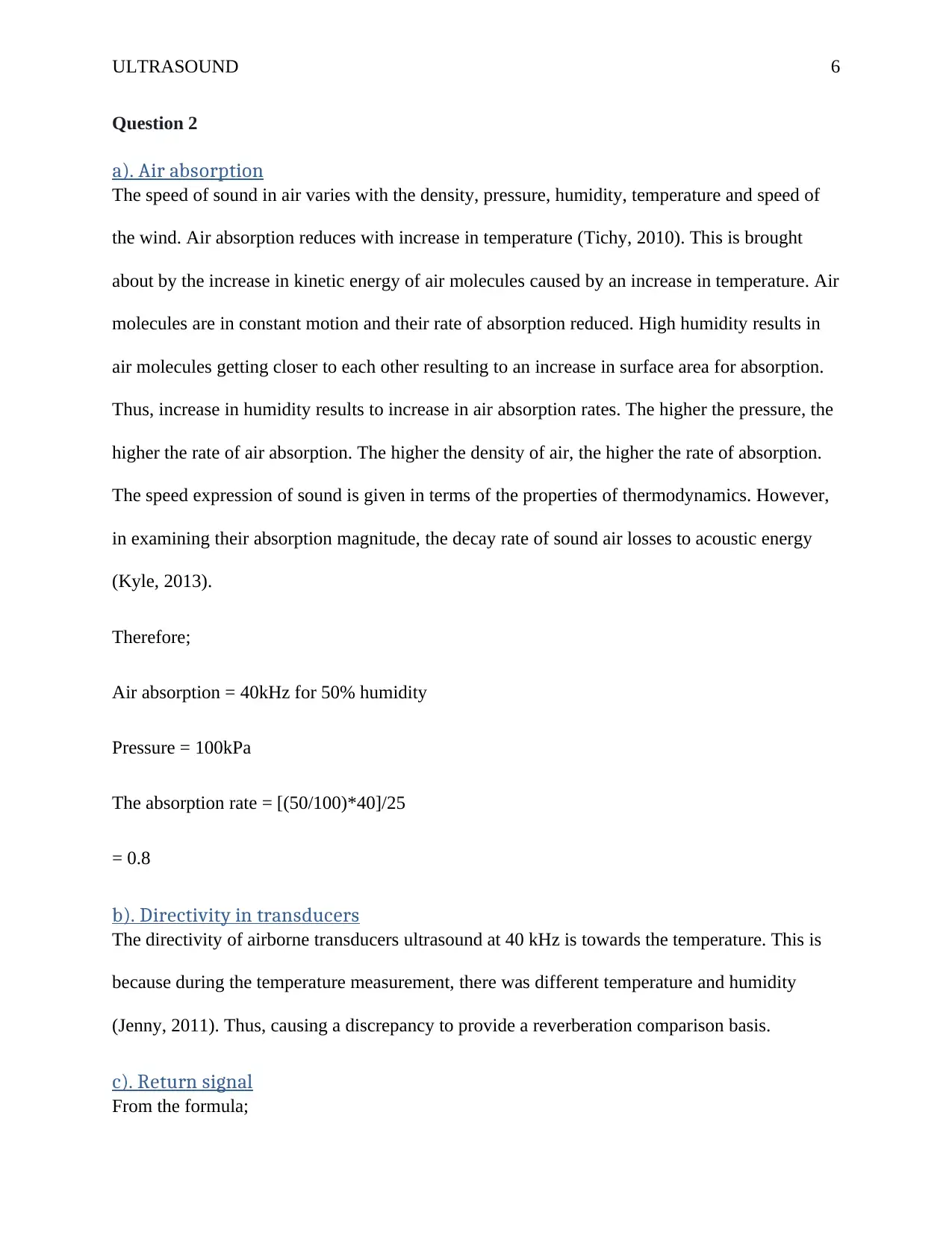
ULTRASOUND 6
Question 2
a). Air absorption
The speed of sound in air varies with the density, pressure, humidity, temperature and speed of
the wind. Air absorption reduces with increase in temperature (Tichy, 2010). This is brought
about by the increase in kinetic energy of air molecules caused by an increase in temperature. Air
molecules are in constant motion and their rate of absorption reduced. High humidity results in
air molecules getting closer to each other resulting to an increase in surface area for absorption.
Thus, increase in humidity results to increase in air absorption rates. The higher the pressure, the
higher the rate of air absorption. The higher the density of air, the higher the rate of absorption.
The speed expression of sound is given in terms of the properties of thermodynamics. However,
in examining their absorption magnitude, the decay rate of sound air losses to acoustic energy
(Kyle, 2013).
Therefore;
Air absorption = 40kHz for 50% humidity
Pressure = 100kPa
The absorption rate = [(50/100)*40]/25
= 0.8
b). Directivity in transducers
The directivity of airborne transducers ultrasound at 40 kHz is towards the temperature. This is
because during the temperature measurement, there was different temperature and humidity
(Jenny, 2011). Thus, causing a discrepancy to provide a reverberation comparison basis.
c). Return signal
From the formula;
Question 2
a). Air absorption
The speed of sound in air varies with the density, pressure, humidity, temperature and speed of
the wind. Air absorption reduces with increase in temperature (Tichy, 2010). This is brought
about by the increase in kinetic energy of air molecules caused by an increase in temperature. Air
molecules are in constant motion and their rate of absorption reduced. High humidity results in
air molecules getting closer to each other resulting to an increase in surface area for absorption.
Thus, increase in humidity results to increase in air absorption rates. The higher the pressure, the
higher the rate of air absorption. The higher the density of air, the higher the rate of absorption.
The speed expression of sound is given in terms of the properties of thermodynamics. However,
in examining their absorption magnitude, the decay rate of sound air losses to acoustic energy
(Kyle, 2013).
Therefore;
Air absorption = 40kHz for 50% humidity
Pressure = 100kPa
The absorption rate = [(50/100)*40]/25
= 0.8
b). Directivity in transducers
The directivity of airborne transducers ultrasound at 40 kHz is towards the temperature. This is
because during the temperature measurement, there was different temperature and humidity
(Jenny, 2011). Thus, causing a discrepancy to provide a reverberation comparison basis.
c). Return signal
From the formula;
⊘ This is a preview!⊘
Do you want full access?
Subscribe today to unlock all pages.

Trusted by 1+ million students worldwide
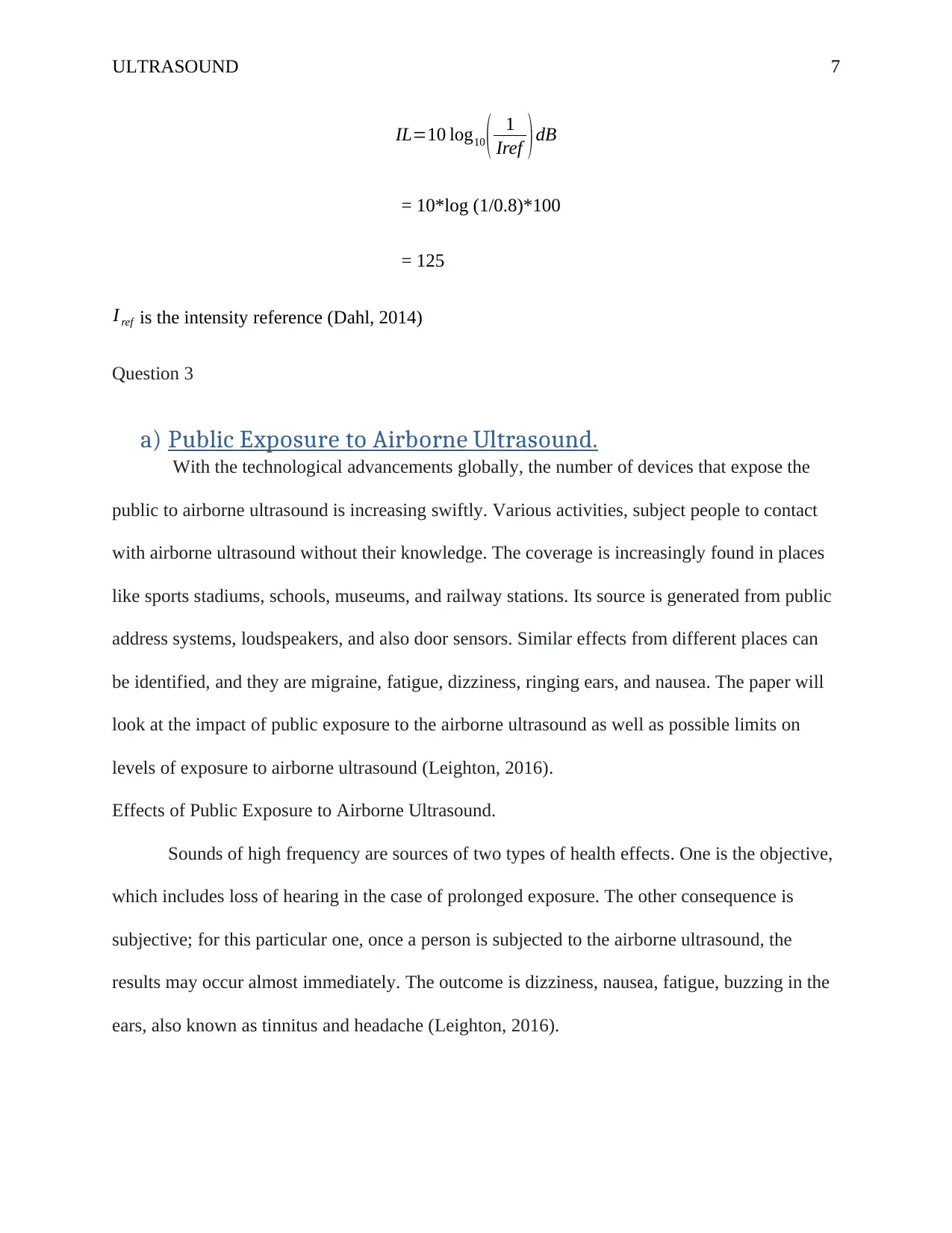
ULTRASOUND 7
IL=10 log10 ( 1
Iref ) dB
= 10*log (1/0.8)*100
= 125
I ref is the intensity reference (Dahl, 2014)
Question 3
a) Public Exposure to Airborne Ultrasound.
With the technological advancements globally, the number of devices that expose the
public to airborne ultrasound is increasing swiftly. Various activities, subject people to contact
with airborne ultrasound without their knowledge. The coverage is increasingly found in places
like sports stadiums, schools, museums, and railway stations. Its source is generated from public
address systems, loudspeakers, and also door sensors. Similar effects from different places can
be identified, and they are migraine, fatigue, dizziness, ringing ears, and nausea. The paper will
look at the impact of public exposure to the airborne ultrasound as well as possible limits on
levels of exposure to airborne ultrasound (Leighton, 2016).
Effects of Public Exposure to Airborne Ultrasound.
Sounds of high frequency are sources of two types of health effects. One is the objective,
which includes loss of hearing in the case of prolonged exposure. The other consequence is
subjective; for this particular one, once a person is subjected to the airborne ultrasound, the
results may occur almost immediately. The outcome is dizziness, nausea, fatigue, buzzing in the
ears, also known as tinnitus and headache (Leighton, 2016).
IL=10 log10 ( 1
Iref ) dB
= 10*log (1/0.8)*100
= 125
I ref is the intensity reference (Dahl, 2014)
Question 3
a) Public Exposure to Airborne Ultrasound.
With the technological advancements globally, the number of devices that expose the
public to airborne ultrasound is increasing swiftly. Various activities, subject people to contact
with airborne ultrasound without their knowledge. The coverage is increasingly found in places
like sports stadiums, schools, museums, and railway stations. Its source is generated from public
address systems, loudspeakers, and also door sensors. Similar effects from different places can
be identified, and they are migraine, fatigue, dizziness, ringing ears, and nausea. The paper will
look at the impact of public exposure to the airborne ultrasound as well as possible limits on
levels of exposure to airborne ultrasound (Leighton, 2016).
Effects of Public Exposure to Airborne Ultrasound.
Sounds of high frequency are sources of two types of health effects. One is the objective,
which includes loss of hearing in the case of prolonged exposure. The other consequence is
subjective; for this particular one, once a person is subjected to the airborne ultrasound, the
results may occur almost immediately. The outcome is dizziness, nausea, fatigue, buzzing in the
ears, also known as tinnitus and headache (Leighton, 2016).
Paraphrase This Document
Need a fresh take? Get an instant paraphrase of this document with our AI Paraphraser
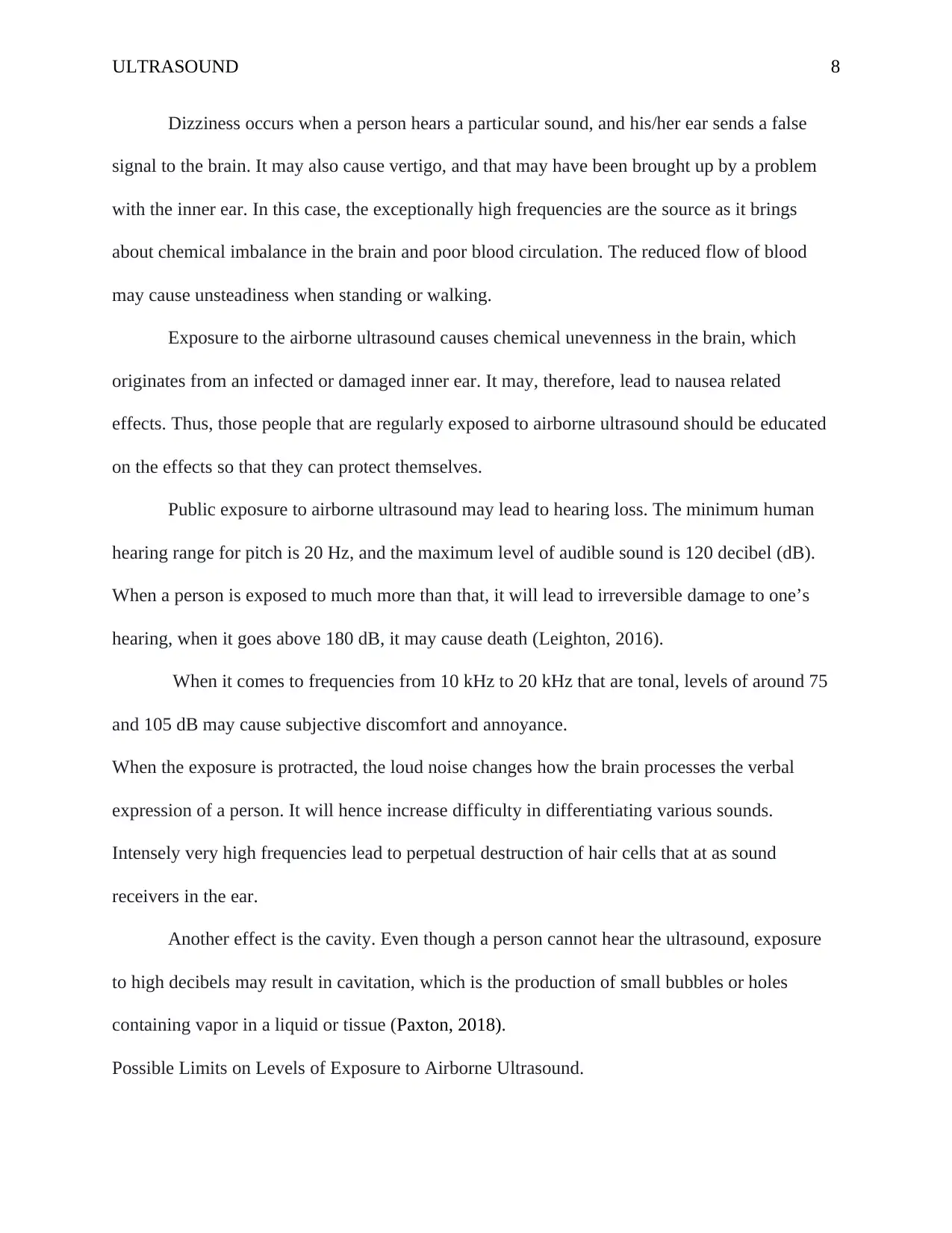
ULTRASOUND 8
Dizziness occurs when a person hears a particular sound, and his/her ear sends a false
signal to the brain. It may also cause vertigo, and that may have been brought up by a problem
with the inner ear. In this case, the exceptionally high frequencies are the source as it brings
about chemical imbalance in the brain and poor blood circulation. The reduced flow of blood
may cause unsteadiness when standing or walking.
Exposure to the airborne ultrasound causes chemical unevenness in the brain, which
originates from an infected or damaged inner ear. It may, therefore, lead to nausea related
effects. Thus, those people that are regularly exposed to airborne ultrasound should be educated
on the effects so that they can protect themselves.
Public exposure to airborne ultrasound may lead to hearing loss. The minimum human
hearing range for pitch is 20 Hz, and the maximum level of audible sound is 120 decibel (dB).
When a person is exposed to much more than that, it will lead to irreversible damage to one’s
hearing, when it goes above 180 dB, it may cause death (Leighton, 2016).
When it comes to frequencies from 10 kHz to 20 kHz that are tonal, levels of around 75
and 105 dB may cause subjective discomfort and annoyance.
When the exposure is protracted, the loud noise changes how the brain processes the verbal
expression of a person. It will hence increase difficulty in differentiating various sounds.
Intensely very high frequencies lead to perpetual destruction of hair cells that at as sound
receivers in the ear.
Another effect is the cavity. Even though a person cannot hear the ultrasound, exposure
to high decibels may result in cavitation, which is the production of small bubbles or holes
containing vapor in a liquid or tissue (Paxton, 2018).
Possible Limits on Levels of Exposure to Airborne Ultrasound.
Dizziness occurs when a person hears a particular sound, and his/her ear sends a false
signal to the brain. It may also cause vertigo, and that may have been brought up by a problem
with the inner ear. In this case, the exceptionally high frequencies are the source as it brings
about chemical imbalance in the brain and poor blood circulation. The reduced flow of blood
may cause unsteadiness when standing or walking.
Exposure to the airborne ultrasound causes chemical unevenness in the brain, which
originates from an infected or damaged inner ear. It may, therefore, lead to nausea related
effects. Thus, those people that are regularly exposed to airborne ultrasound should be educated
on the effects so that they can protect themselves.
Public exposure to airborne ultrasound may lead to hearing loss. The minimum human
hearing range for pitch is 20 Hz, and the maximum level of audible sound is 120 decibel (dB).
When a person is exposed to much more than that, it will lead to irreversible damage to one’s
hearing, when it goes above 180 dB, it may cause death (Leighton, 2016).
When it comes to frequencies from 10 kHz to 20 kHz that are tonal, levels of around 75
and 105 dB may cause subjective discomfort and annoyance.
When the exposure is protracted, the loud noise changes how the brain processes the verbal
expression of a person. It will hence increase difficulty in differentiating various sounds.
Intensely very high frequencies lead to perpetual destruction of hair cells that at as sound
receivers in the ear.
Another effect is the cavity. Even though a person cannot hear the ultrasound, exposure
to high decibels may result in cavitation, which is the production of small bubbles or holes
containing vapor in a liquid or tissue (Paxton, 2018).
Possible Limits on Levels of Exposure to Airborne Ultrasound.
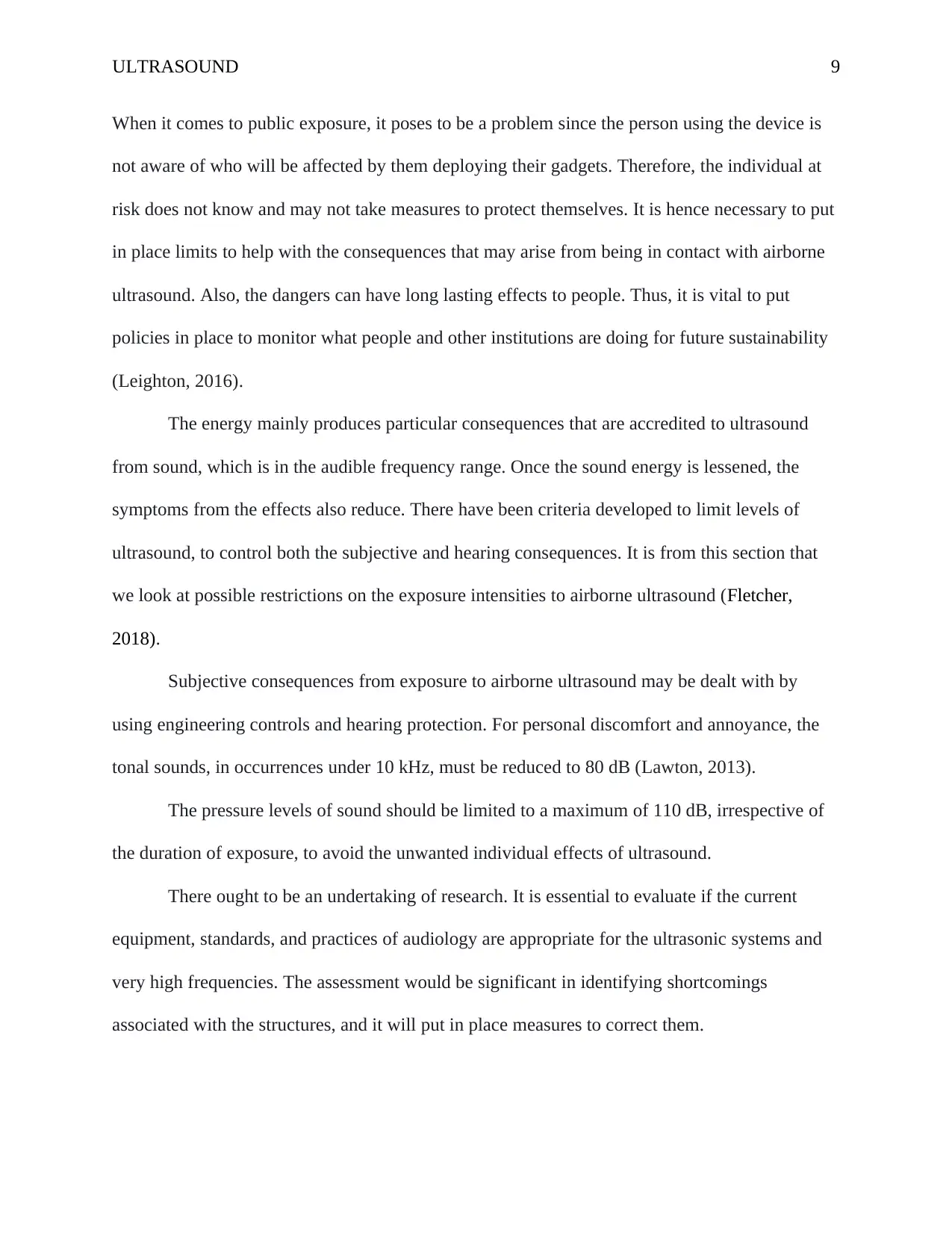
ULTRASOUND 9
When it comes to public exposure, it poses to be a problem since the person using the device is
not aware of who will be affected by them deploying their gadgets. Therefore, the individual at
risk does not know and may not take measures to protect themselves. It is hence necessary to put
in place limits to help with the consequences that may arise from being in contact with airborne
ultrasound. Also, the dangers can have long lasting effects to people. Thus, it is vital to put
policies in place to monitor what people and other institutions are doing for future sustainability
(Leighton, 2016).
The energy mainly produces particular consequences that are accredited to ultrasound
from sound, which is in the audible frequency range. Once the sound energy is lessened, the
symptoms from the effects also reduce. There have been criteria developed to limit levels of
ultrasound, to control both the subjective and hearing consequences. It is from this section that
we look at possible restrictions on the exposure intensities to airborne ultrasound (Fletcher,
2018).
Subjective consequences from exposure to airborne ultrasound may be dealt with by
using engineering controls and hearing protection. For personal discomfort and annoyance, the
tonal sounds, in occurrences under 10 kHz, must be reduced to 80 dB (Lawton, 2013).
The pressure levels of sound should be limited to a maximum of 110 dB, irrespective of
the duration of exposure, to avoid the unwanted individual effects of ultrasound.
There ought to be an undertaking of research. It is essential to evaluate if the current
equipment, standards, and practices of audiology are appropriate for the ultrasonic systems and
very high frequencies. The assessment would be significant in identifying shortcomings
associated with the structures, and it will put in place measures to correct them.
When it comes to public exposure, it poses to be a problem since the person using the device is
not aware of who will be affected by them deploying their gadgets. Therefore, the individual at
risk does not know and may not take measures to protect themselves. It is hence necessary to put
in place limits to help with the consequences that may arise from being in contact with airborne
ultrasound. Also, the dangers can have long lasting effects to people. Thus, it is vital to put
policies in place to monitor what people and other institutions are doing for future sustainability
(Leighton, 2016).
The energy mainly produces particular consequences that are accredited to ultrasound
from sound, which is in the audible frequency range. Once the sound energy is lessened, the
symptoms from the effects also reduce. There have been criteria developed to limit levels of
ultrasound, to control both the subjective and hearing consequences. It is from this section that
we look at possible restrictions on the exposure intensities to airborne ultrasound (Fletcher,
2018).
Subjective consequences from exposure to airborne ultrasound may be dealt with by
using engineering controls and hearing protection. For personal discomfort and annoyance, the
tonal sounds, in occurrences under 10 kHz, must be reduced to 80 dB (Lawton, 2013).
The pressure levels of sound should be limited to a maximum of 110 dB, irrespective of
the duration of exposure, to avoid the unwanted individual effects of ultrasound.
There ought to be an undertaking of research. It is essential to evaluate if the current
equipment, standards, and practices of audiology are appropriate for the ultrasonic systems and
very high frequencies. The assessment would be significant in identifying shortcomings
associated with the structures, and it will put in place measures to correct them.
⊘ This is a preview!⊘
Do you want full access?
Subscribe today to unlock all pages.

Trusted by 1+ million students worldwide
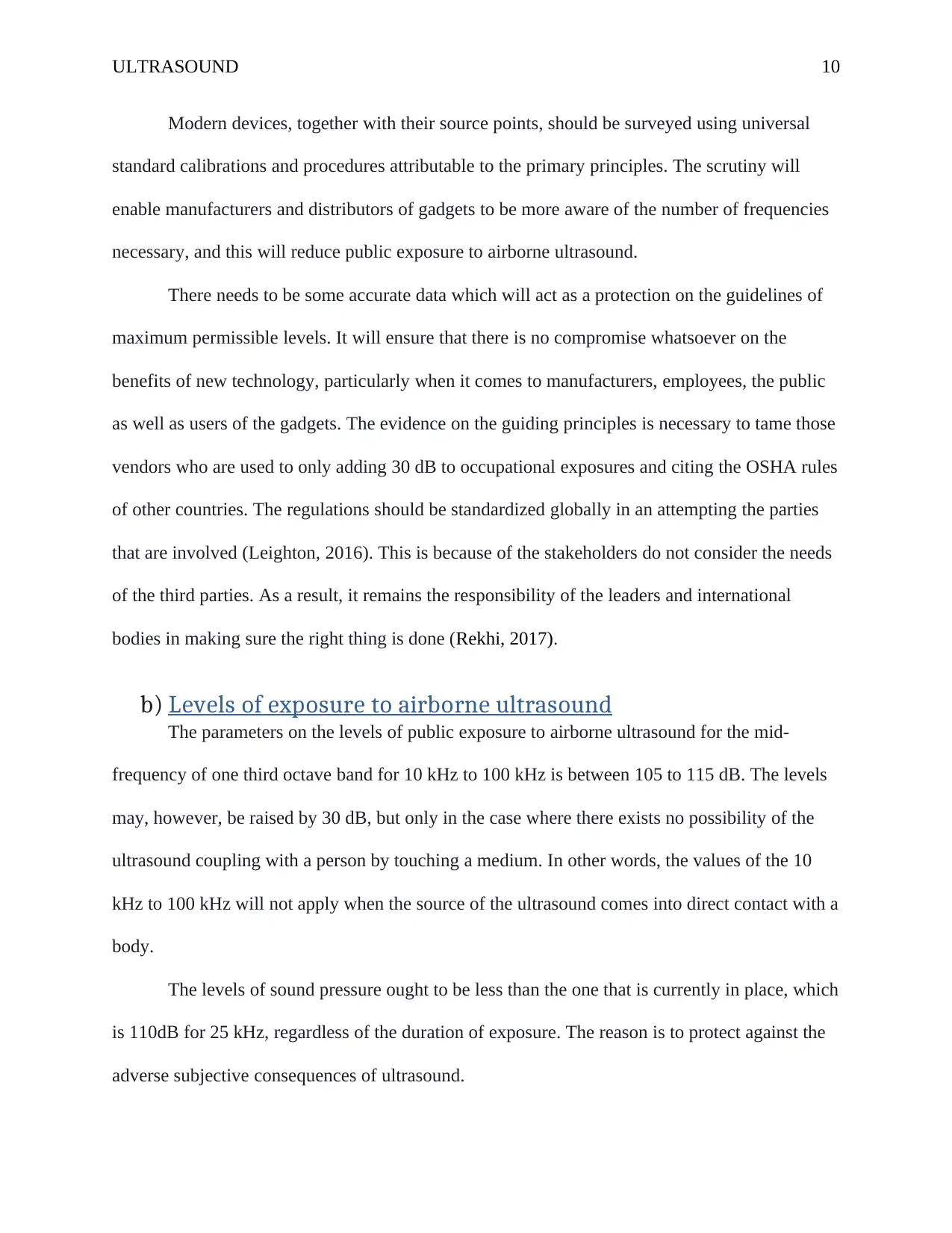
ULTRASOUND 10
Modern devices, together with their source points, should be surveyed using universal
standard calibrations and procedures attributable to the primary principles. The scrutiny will
enable manufacturers and distributors of gadgets to be more aware of the number of frequencies
necessary, and this will reduce public exposure to airborne ultrasound.
There needs to be some accurate data which will act as a protection on the guidelines of
maximum permissible levels. It will ensure that there is no compromise whatsoever on the
benefits of new technology, particularly when it comes to manufacturers, employees, the public
as well as users of the gadgets. The evidence on the guiding principles is necessary to tame those
vendors who are used to only adding 30 dB to occupational exposures and citing the OSHA rules
of other countries. The regulations should be standardized globally in an attempting the parties
that are involved (Leighton, 2016). This is because of the stakeholders do not consider the needs
of the third parties. As a result, it remains the responsibility of the leaders and international
bodies in making sure the right thing is done (Rekhi, 2017).
b) Levels of exposure to airborne ultrasound
The parameters on the levels of public exposure to airborne ultrasound for the mid-
frequency of one third octave band for 10 kHz to 100 kHz is between 105 to 115 dB. The levels
may, however, be raised by 30 dB, but only in the case where there exists no possibility of the
ultrasound coupling with a person by touching a medium. In other words, the values of the 10
kHz to 100 kHz will not apply when the source of the ultrasound comes into direct contact with a
body.
The levels of sound pressure ought to be less than the one that is currently in place, which
is 110dB for 25 kHz, regardless of the duration of exposure. The reason is to protect against the
adverse subjective consequences of ultrasound.
Modern devices, together with their source points, should be surveyed using universal
standard calibrations and procedures attributable to the primary principles. The scrutiny will
enable manufacturers and distributors of gadgets to be more aware of the number of frequencies
necessary, and this will reduce public exposure to airborne ultrasound.
There needs to be some accurate data which will act as a protection on the guidelines of
maximum permissible levels. It will ensure that there is no compromise whatsoever on the
benefits of new technology, particularly when it comes to manufacturers, employees, the public
as well as users of the gadgets. The evidence on the guiding principles is necessary to tame those
vendors who are used to only adding 30 dB to occupational exposures and citing the OSHA rules
of other countries. The regulations should be standardized globally in an attempting the parties
that are involved (Leighton, 2016). This is because of the stakeholders do not consider the needs
of the third parties. As a result, it remains the responsibility of the leaders and international
bodies in making sure the right thing is done (Rekhi, 2017).
b) Levels of exposure to airborne ultrasound
The parameters on the levels of public exposure to airborne ultrasound for the mid-
frequency of one third octave band for 10 kHz to 100 kHz is between 105 to 115 dB. The levels
may, however, be raised by 30 dB, but only in the case where there exists no possibility of the
ultrasound coupling with a person by touching a medium. In other words, the values of the 10
kHz to 100 kHz will not apply when the source of the ultrasound comes into direct contact with a
body.
The levels of sound pressure ought to be less than the one that is currently in place, which
is 110dB for 25 kHz, regardless of the duration of exposure. The reason is to protect against the
adverse subjective consequences of ultrasound.
Paraphrase This Document
Need a fresh take? Get an instant paraphrase of this document with our AI Paraphraser
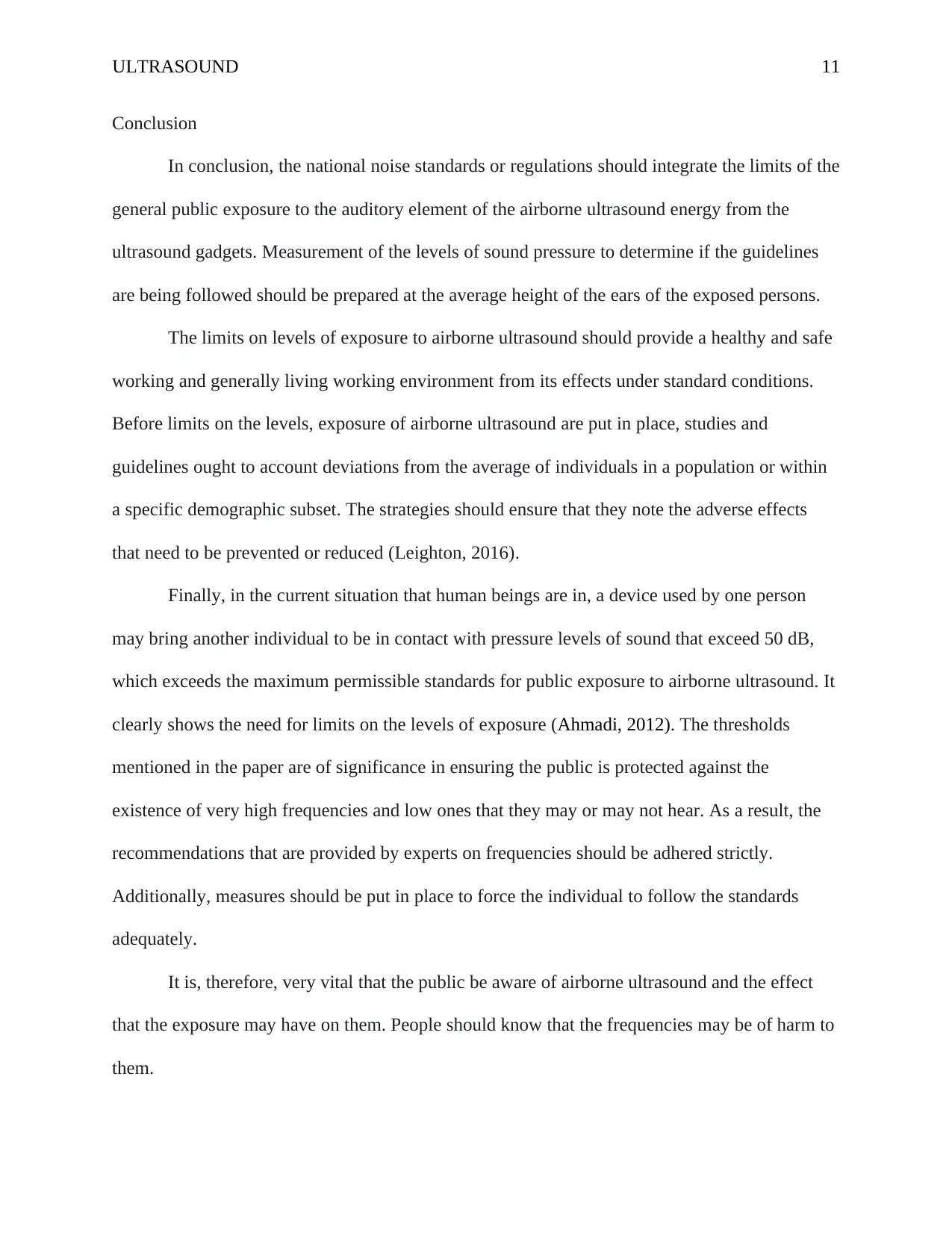
ULTRASOUND 11
Conclusion
In conclusion, the national noise standards or regulations should integrate the limits of the
general public exposure to the auditory element of the airborne ultrasound energy from the
ultrasound gadgets. Measurement of the levels of sound pressure to determine if the guidelines
are being followed should be prepared at the average height of the ears of the exposed persons.
The limits on levels of exposure to airborne ultrasound should provide a healthy and safe
working and generally living working environment from its effects under standard conditions.
Before limits on the levels, exposure of airborne ultrasound are put in place, studies and
guidelines ought to account deviations from the average of individuals in a population or within
a specific demographic subset. The strategies should ensure that they note the adverse effects
that need to be prevented or reduced (Leighton, 2016).
Finally, in the current situation that human beings are in, a device used by one person
may bring another individual to be in contact with pressure levels of sound that exceed 50 dB,
which exceeds the maximum permissible standards for public exposure to airborne ultrasound. It
clearly shows the need for limits on the levels of exposure (Ahmadi, 2012). The thresholds
mentioned in the paper are of significance in ensuring the public is protected against the
existence of very high frequencies and low ones that they may or may not hear. As a result, the
recommendations that are provided by experts on frequencies should be adhered strictly.
Additionally, measures should be put in place to force the individual to follow the standards
adequately.
It is, therefore, very vital that the public be aware of airborne ultrasound and the effect
that the exposure may have on them. People should know that the frequencies may be of harm to
them.
Conclusion
In conclusion, the national noise standards or regulations should integrate the limits of the
general public exposure to the auditory element of the airborne ultrasound energy from the
ultrasound gadgets. Measurement of the levels of sound pressure to determine if the guidelines
are being followed should be prepared at the average height of the ears of the exposed persons.
The limits on levels of exposure to airborne ultrasound should provide a healthy and safe
working and generally living working environment from its effects under standard conditions.
Before limits on the levels, exposure of airborne ultrasound are put in place, studies and
guidelines ought to account deviations from the average of individuals in a population or within
a specific demographic subset. The strategies should ensure that they note the adverse effects
that need to be prevented or reduced (Leighton, 2016).
Finally, in the current situation that human beings are in, a device used by one person
may bring another individual to be in contact with pressure levels of sound that exceed 50 dB,
which exceeds the maximum permissible standards for public exposure to airborne ultrasound. It
clearly shows the need for limits on the levels of exposure (Ahmadi, 2012). The thresholds
mentioned in the paper are of significance in ensuring the public is protected against the
existence of very high frequencies and low ones that they may or may not hear. As a result, the
recommendations that are provided by experts on frequencies should be adhered strictly.
Additionally, measures should be put in place to force the individual to follow the standards
adequately.
It is, therefore, very vital that the public be aware of airborne ultrasound and the effect
that the exposure may have on them. People should know that the frequencies may be of harm to
them.

ULTRASOUND 12
⊘ This is a preview!⊘
Do you want full access?
Subscribe today to unlock all pages.

Trusted by 1+ million students worldwide
1 out of 14
Your All-in-One AI-Powered Toolkit for Academic Success.
+13062052269
info@desklib.com
Available 24*7 on WhatsApp / Email
![[object Object]](/_next/static/media/star-bottom.7253800d.svg)
Unlock your academic potential
Copyright © 2020–2025 A2Z Services. All Rights Reserved. Developed and managed by ZUCOL.